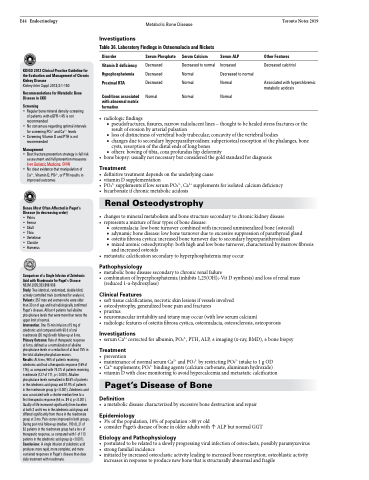Page 286 - TNFlipTest
P. 286
E44 Endocrinology
Metabolic Bone Disease
Toronto Notes 2019
Investigations
Table 36. Laboratory Findings in Osteomalacia and Rickets
KDIGO 2012 Clinical Practice Guideline for the Evaluation and Management of Chronic Kidney Disease
Kidney Inter Suppl 2013;3:1-150
Recommendations for Metabolic Bone Disease in CKD
Screening
• Regular bone mineral density screening of patients with eGFR<45 is not recommended
• No consensus regarding optimal intervals for screening PO43- and Ca2+ levels
• Screening Vitamin D and PTH is not recommended
Management
• Best fracture prevention strategy is fall risk assessment and fall prevention measures (see Geriatric Medicine, GM4)
• No clear evidence that manipulation of Ca2+, Vitamin D, PO43-, or PTH results in improved outcomes
Bones Most Often Affected in Paget’s Disease (in decreasing order)
• Pelvis
• Femur
• Skull
• Tibia
• Vertebrae • Clavicle • Humerus
Comparison of a Single Infusion of Zoledronic Acid with Risedronate for Paget’s Disease NEJM 2005;353:898-908
Study: Two identical, randomized, double-blind, actively controlled trials (combined for analysis). Patients: 357 men and women who were older than 30 yr of age and had radiologically confirmed Paget’s disease. All but 4 patients had alkaline phosphatase levels that were more than twice the upper limit of normal.
Intervention: One 15-min infusion of 5 mg of zoledronic acid compared with 60 d of oral risedronate (30 mg/d) with follow-up at 6 mo. Primary Outcome: Rate of therapeutic response at 6 mo, defined as a normalization of alkaline phosphatase levels or a reduction of at least 75% in the total alkaline phosphatase excess.
Results: At 6 mo, 96% of patients receiving zoledronic acid had a therapeutic response (169 of 176), as compared with 74.3% of patients receiving risedronate (127 of 171, p<0.001). Alkaline phosphatase levels normalized in 88.6% of patients in the zoledronic acid group and 57.9% of patients in the risedronate group (p<0.001). Zoledronic acid was associated with a shorter median time to a first therapeutic response (64 vs. 89 d, p<0.001). Quality of life increased significantly from baseline at both 3 and 6 mo in the zoledronic acid group and differed significantly from those in the risedronate group at 3 mo. Pain scores improved in both groups. During post-trial follow-up (median, 190 d), 21 of
82 patients in the risedronate group had a loss of therapeutic response, as compared with 1 of 113 patients in the zoledronic acid group (p<0.001). Conclusions: A single infusion of zoledronic acid produces more rapid, more complete, and more sustained responses in Paget’s disease than does daily treatment with risedronate.
Disorder
Vitamin D deficiency Hypophosphatemia Proximal RTA
Conditions associated with abnormal matrix formation
Serum Phosphate
Decreased Decreased Decreased
Normal
Serum Calcium
Decreased to normal Normal
Normal
Normal
Serum ALP
Increased Decreased to normal Normal
Normal
Other Features
Decreased calcitriol
Associated with hyperchloremic metabolic acidosis
• radiologicfindings
■ pseudofractures, fissures, narrow radiolucent lines – thought to be healed stress fractures or the
result of erosion by arterial pulsation
■ loss of distinctness of vertebral body trabeculae; concavity of the vertebral bodies
■ changes due to secondary hyperparathyroidism: subperiosteal resorption of the phalanges, bone
cysts, resorption of the distal ends of long bones
■ others: bowing of tibia, coxa profundus hip deformity
• bonebiopsy:usuallynotnecessarybutconsideredthegoldstandardfordiagnosis
Treatment
• definitive treatment depends on the underlying cause
• vitamin D supplementation
• PO43- supplements if low serum PO43-, Ca2+ supplements for isolated calcium deficiency • bicarbonateifchronicmetabolicacidosis
Renal Osteodystrophy
• changestomineralmetabolismandbonestructuresecondarytochronickidneydisease • represents a mixture of four types of bone disease:
■ osteomalacia: low bone turnover combined with increased unmineralized bone (osteoid)
■ adynamic bone disease: low bone turnover due to excessive suppression of parathyroid gland
■ osteitis fibrosa cystica: increased bone turnover due to secondary hyperparathyroidism
■ mixed uremic osteodystrophy: both high and low bone turnover, characterized by marrow fibrosis
and increased osteoids
• metastaticcalcificationsecondarytohyperphosphatemiamayoccur
Pathophysiology
• metabolicbonediseasesecondarytochronicrenalfailure
• combinationofhyperphosphatemia(inhibits1,25(OH)2-VitDsynthesis)andlossofrenalmass
(reduced 1-α-hydroxylase)
Clinical Features
• softtissuecalcifications,necroticskinlesionsifvesselsinvolved
• osteodystrophy,generalizedbonepainandfractures
• pruritus
• neuromuscularirritabilityandtetanymayoccur(withlowserumcalcium)
• radiologicfeaturesofosteitisfibrosacystica,osteomalacia,osteosclerosis,osteoporosis
Investigations
• serumCa2+correctedforalbumin,PO43-,PTH,ALP,±imaging(x-ray,BMD),±bonebiopsy
Treatment
• prevention
• maintenance of normal serum Ca2+ and PO43- by restricting PO43- intake to 1 g OD
• Ca2+ supplements; PO43- binding agents (calcium carbonate, aluminum hydroxide)
• vitaminDwithclosemonitoringtoavoidhypercalcemiaandmetastaticcalcification
Paget’s Disease of Bone
Definition
• ametabolicdiseasecharacterizedbyexcessivebonedestructionandrepair
Epidemiology
• 3%ofthepopulation,10%ofpopulation>80yrold
• considerPaget’sdiseaseofboneinolderadultswith↑ALPbutnormalGGT
Etiology and Pathophysiology
• postulatedtoberelatedtoaslowlyprogressingviralinfectionofosteoclasts,possiblyparamyxovirus • strong familial incidence
• initiatedbyincreasedosteoclasticactivityleadingtoincreasedboneresorption;osteoblasticactivity
increases in response to produce new bone that is structurally abnormal and fragile


